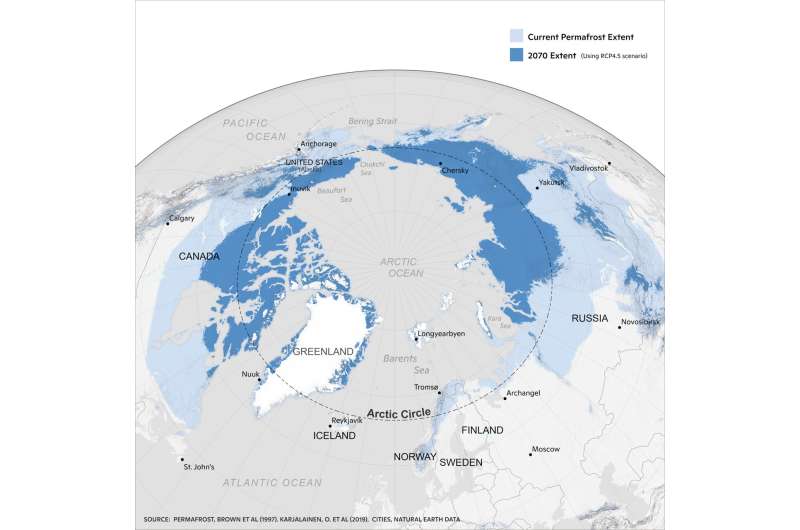This article has been reviewed according to Science X's editorial process and policies. Editors have highlighted the following attributes while ensuring the content's credibility:
fact-checked
peer-reviewed publication
trusted source
proofread
Most Earth system models are missing key piece of future climate puzzle, researchers say

The way science is funded is hampering Earth system models, and may be skewing important climate predictions, according to a new comment published in Nature Climate Change by Woodwell Climate Research Center and an international team of model experts.
Emissions from thawing permafrost, frozen ground in the North that contains twice as much carbon as the atmosphere does and is thawing due to human-caused climate warming, are one of the largest uncertainties in future climate projections. But accurate representation of permafrost dynamics is missing from the major models that project future carbon emissions.
Only two of the eleven Earth system models (ESMs) used in the last Intergovernmental Panel on Climate Change (IPCC) report include permafrost carbon cycling at all, and those that do currently use over-simplified approximations that don't capture the fully dynamic ways that permafrost carbon can be released into the atmosphere as the climate warms. Processes that researchers have observed in the field, such as the way abrupt permafrost thaw can create ponds and lakes and change surface hydrology, run counter to these approximations but have large implications for permafrost carbon and its potential impact on the global climate.
"What happens to the carbon in permafrost is one of the biggest unknowns about our future climate," said Christina Schaedel, senior research scientist at Woodwell Climate Research Center and lead author of the report. "Earth system models are critical to predicting where, how and when this carbon will be released, but modeling teams currently don't have the resources they need to depict permafrost accurately. If we want more accurate climate predictions, that needs to change."
Earth system models, the supercomputer-driven programs that can forecast future carbon emissions and climate dynamics, can predict only the processes that they represent. And as scientists learn more about the complex physical and biogeochemical interactions that make up the Earth system, ESMs have grown in complexity, encompassing more and more processes. In practice, that means years of highly technical code development, integrating observational data, and parameterizing and testing the model.
But most science research funding operates on a three-year funding cycle and is structured around projects that tackle novel science questions. This relatively short cycle is too brief a time to train up model developers or to complete key and complex model development steps before teams turn over, the authors say.
"As these modeling systems are becoming increasingly complex, it is hard—and getting harder—for a graduate student or postdoc to 'come up to speed' quickly enough to really understand the full scope of the model development needs and wrap up a development project on the typical three-year timeline of a proposal," said David Lawrence, who co-leads the Community Terrestrial Systems Model at the National Center for Atmospheric Research. "Unfortunately, that leaves many projects unfinished."
Lawrence, who co-authored the report, said that while the collaborative modeling teams he works with are making advances in depicting complex permafrost processes, limited funding means that "the pace at which improvements get ingested back into the core CTSM codebase is relatively slow."
"Substantial funding, on the order of multiple millions of dollars per ESM, is needed to provide the necessary infrastructure and support needed for model development," the authors write. Such targeted funding and highly skilled software developers and programmers, they contend, can help speed the model improvement that's underway.
"In recent years, Arctic research has become very collaborative and complex—scientists are not just studying one plant in one location anymore," said Schaedel. "And while the need for long-term data and complex model development has become ever more apparent, the funding availability has not kept up. We'd like to see funding opportunities match the climate challenges that we're facing."
"Our understanding of how permafrost is thawing and emitting carbon has drastically improved over the last 15 years," said Brendan Rogers, associate scientist at Woodwell Climate Research Center and co-lead of the Permafrost Pathways project. "Funding Earth system models to represent permafrost thaw would ensure those gains are realized in the models, and that critical climate targets and carbon budgets are being based on the best science we have."
More information: Earth system models must include permafrost carbon processes, Nature Climate Change (2024). DOI: 10.1038/s41558-023-01909-9. www.nature.com/articles/s41558-023-01909-9
Journal information: Nature Climate Change
Provided by Woodwell Climate Research Center




















